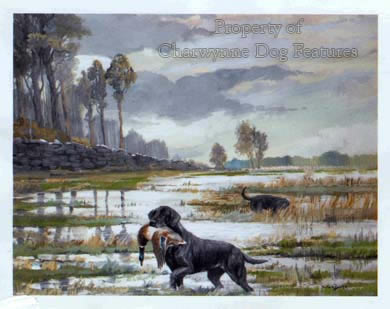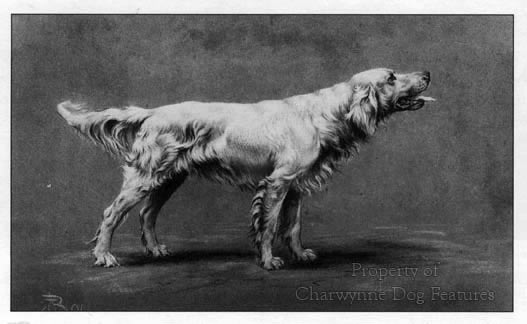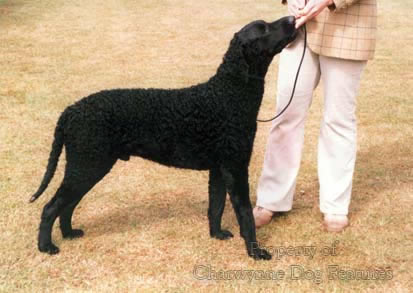12 THE ORIGIN OF THE RETRIEVER
THE ORIGIN OF THE RETRIEVER
by David Hancock
 “A glorious breed of dog is the retriever, useful alike for sporting and for domestic purposes;
“A glorious breed of dog is the retriever, useful alike for sporting and for domestic purposes;
his sagacity, good temper, and intelligence endear him to all lovers of the canine race.”
Those few words by Webb in his quaintly entitled Dogs: their points, whims, instincts, and peculiarities, Dean & Son, 1883, give an instant snapshot of this ever-popular type of gundog. Retrievers are uniquely British and reflect the way in which British sportsmen have chosen to operate in the shooting field in the last century or so. Sporting writers down the years have always found something nice to say about the retrievers. Stern taskmasters driven mad by the waywardness of cockers, the selective deafness of bassets and the wildness of hunt terriers have rarely rubbished the retrievers. Quite the reverse; their prose on this subject has frequently been inspired. And yet the field role of the working retriever is a demanding one. I didn't agree with the distinguished gundog writer, Wilson Stephens, when he once described the task of retrieving shot game as "a simple act of porterage". The recall needed for marking falling game, the nosework required for game-finding and the softness of mouth to retrieve to hand calls for a variety of skills. Picking up in a gale-force wind or sitting in a freezing estuary on a December dawn is not a job for the faint-hearted. Retrievers have to have character. 
A descriptive noun usually comes quickly to mind when a dog fancier conjures up a mind image of a group of dogs. For me, the sighthounds have elegance, the mastiff group stoicism, the terriers tenacity, the scenthounds single-mindedness and the spaniels merriment. So many Toy dogs have a certain coquettishness about them. The Bull Terriers always seem to have a glint in their eye. The retrievers, as British as terriers, I always connect with charm. So many of them are simply delightful, captivating and easily attract admiration. Seeing the eternally waving tails of Golden Retrievers always gives me pleasure. All the retriever breeds charm their owners and back that with wide-ranging usefulness.
Important historical information on ships’ dogs used as fishing dogs in the south of England can be found in the words of the 6th Earl of Malmesbury, when contributing to the booklet The Labrador Retriever Club’s A Celebration of 75 Years, published by the club in 1991. He wrote: “My great great grandfather needed a good retrieving water dog, and a companion in the home. He found both qualities in the little Newfoundlander (later to be renamed the Labrador, which was a less cumbersome name. How did these dogs develop their retrieving instinct? It was customary for the fishing boats in Newfoundland to carry dogs. These dogs developed their retrieving instinct in two distinct ways. Fish hooks were not as well made as they are today. A large fish, when brought to the surface, might free itself from the hook. A dog with a special harness would be lowered from the deck – grab the fish – and be hauled back on board with, hopefully, the fish still in its mouth…I know from my own experience that many of these dogs have still inherited this retrieving of fish.” Preserved in the Natural History Museum outpost at Tring is a ‘Trawler Spaniel’, a parti-coloured dog, just under a foot high, resembling the small sporting spaniels found here and on the Continent, often included by artists in family portraits.
The Earl went on to point out that when his ancestor was importing dogs from the Newfoundland Fishing Fleet unloading in Poole Harbour, the fishing industry in Christchurch and Bournemouth Harbours was intensive and the need for dogs extensive. Further north, the great retriever authority, Stanley O’Neill, recorded that his father was Superintendent of Grimsby Fish Docks, and he went with him to visit every port where fish was landed in England and Scotland, writing “I saw hundreds of water dogs around Grimsby and Yarmouth which were ships dogs, and it was well known that a cross with them to improve retrieving from water had been the origin of the curly-coats. In 1903, at Alnmouth, he saw men netting for salmon with a dog with a wavy or curly coat and of a tawny colour”. When he asked about the dog he was told it was a Tweed Water Spaniel. Such a dog was behind many of our emerging land retrievers, with what became the Golden Retriever, gaining from this type and coat colour. In his The Complete Farrier of
Origins
There have been claims in modern books on retrievers, published unsurprisingly in North America, that the Newfoundland, sometimes called the Father of the Retriever, was developed in North America from local stock, existing before Europeans arrived there. Such claims link early types of this breed with big draught dogs, of spitz type, used by the native Indians, and themselves originating from the other side of the continent, near the Baring Straits. The use of the blood of the Tibetan Mastiff has been claimed by these theorists, just as that of the Pyrenean Mountain Dog, a similarly-sized breed. Before the days of pure-breeding, man bred good dog to good dog, dogs excelling in the function desired. I have already covered the extensive use of ships dogs/fishing dogs along the eastern seaboard of North America in times past and refer to it again at the end of this retriever section. If, as a fisherman or seafarer you needed a better ships’ dog or an improved draught dog, and one able to cope with extreme climatic conditions, you would have brought in the blood of suitable local dogs, but never at the expense of the primary function. French ships would have carried dogs like the Barbet; Portuguese ships would have had dogs like their Cao de Agua; English ships would have had dogs from ports like Plymouth and Poole, with perhaps those from Scotland having a type like the Tweed Water Dog. Out of this mix came the dogs taken back to Britain to enhance our native types, used as retrievers. 
The retriever breeds must be retained as working breeds and their conformation, character and commitment perpetuated with that in mind, ahead of rosette-winning and fashion of the day. These breeds were developed in a hard school and their precious physical and mental qualities handed on to us to be safeguarded in our lifetime as a matter of honour. We owe it to this charming and valuable group of breeds that those who come after us will respect our contribution to their best long-term interests. Such a contribution is richly deserved. Long may we enjoy our reliable retrievers!
“A retriever is, to our mind, the king of all sporting dogs. He has none of the heaviness (or stupidity) of the pointer, or the fawning adulation for his master shown by the setter or spaniel. His mien is dignified, his actions show the height of animal intelligence, and he is affectionate and companionable as is no other dog used for shooting…His actions do not run in a groove, as do those of the pointer, setter or spaniel, for he often has to act, and on the moment judge for himself, what is correct behaviour on his part, and what is not; and if well broken his thoughtful sagacity rarely fails him, though he be out of sight and hearing of his trainer.”
From Shooting, The Badminton Library, Longmans, 1886.